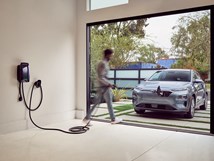BMW Unveils Fuel Cell and Plug-in Hybrid Test Vehicles
This week BMW AG took the wraps off a fuel cell-powered demonstrator vehicle based on the midsize 5 Series Gran Turismo car
The test car runs on gaseous hydrogen stored at 700 bar in a tank that uses BMW's patented cryogenic pressure technology.
#hybrid
This week BMW AG took the wraps off a fuel cell-powered demonstrator vehicle based on the midsize 5 Series Gran Turismo car
The test car runs on gaseous hydrogen stored at 700 bar in a tank that uses BMW's patented cryogenic pressure technology. The company says the system gives the fuel-cell vehicle a driving range of more than 300 miles per fill-up.
The vehicle's fuel cells, housing and ancillary systems were developed under a three-year-old partnership with Toyota Motor Corp. The companies aim to commercialize the technology by 2020.
BMW also unveiled a plug-in hybrid variant of its 2 Series Active Tourer. The prototype's all-wheel-drive, plug-in hybrid system is similar in configuration to the one used in the company's i8 supercar, but in reverse order. In the Active Tourer, a twin-turbo, 1.5-liter 3-cylinder engine powers the front wheels rather than the rears, and and a generator and electric motor are used in the rear.
The hybrid package produces a combined 224 hp and 284 lb-ft or torque. The powertrain is mated with a 6-speed transmission in the front and a bolted-on 2-speed unit in the rear.
BMW calculates the hybrid car would get 117 mpg and emit about 50 g/km of carbon dioxide on the European driving cycle. The vehicle can travel as far as 23 miles in all-electric mode, according to the company.
RELATED CONTENT
-
Plastics: The Tortoise and the Hare
Plastic may not be in the news as much as some automotive materials these days, but its gram-by-gram assimilation could accelerate dramatically.
-
The Koenigsegg Jesko Has An Amazing Engine
It is hard to believe that this is a vehicle in “serial” production with such extraordinary powertrain performance
-
GM Develops a New Electrical Platform
GM engineers create a better electrical architecture that can handle the ever-increasing needs of vehicle systems








